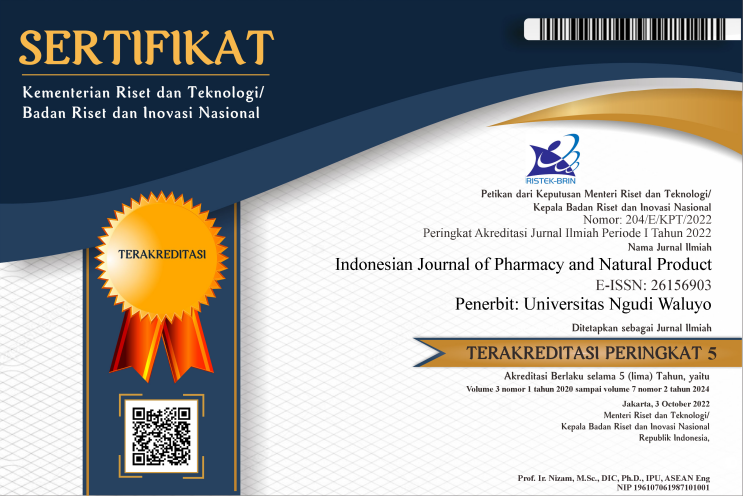Aktivitas Antihiperurisemia dan Evaluasi Sifat Fisik Sediaan Sirup Ekstrak Labu Kuning ( Cucurbita maxima )
DOI:
https://doi.org/10.35473/ijpnp.v4i1.973Keywords:
antihiperurisemia, ekstrak labu kuning, sirup, flavonoidAbstract
Konsumsi makanan tinggi purin akan menyebabkan peningkatan kadar asam urat dalam darah. Akibat kadar asam urat yang tinggi ( hiperurisemia) dan yang tidak terkontrol, akan menyebabkan gangguan pada organ tubuh sehingga timbul penyakit jantung, ginjal maupun Diabetes Mellitus. Allopurinol saat ini masih digunakan sebagai terapi asam urat / gout tetapi memiliki efek samping ruam, gangguan pencernaan, gangguan ginjal dan hati. Tujuan dari penelitian ini untuk mengkaji ekstrak labu kuning yang mengandung flavonoid dan terpenoid dapat digunakan sebagai terapi antihiperurisemia akibat adanya induksi pakan tinggi purin yaitu jus hati dan melinjo (1:1) selama 30 hari. Konsentrasi ekstrak yang digunakan 200 mg/KgBB, 400 mg/KgBB dan 600 mg/KgBB diberikan selama 7 hari dan dibuat sediaan sirup untuk memudahkan penggunaan. Formulasi sirup diuji sifat fisik dan karakteristik berdasar SNI. Hasil penelitian, menunjukkan bahwa ELBK 600 mg/KgBB memiliki aktivitas antihiperurisemia sebanding dengan Allopurinol (p value = 0,436 > 0,05), dan peningkatan konsentrasi ELBK memberikan aktivitas yang berbeda terhadap penurunan kadar asam urat (p value= 0,00). Sediaan formulasi sirup belum memenuhi syarat mutu SNI karena pH masih asam, kadar gula dibawah 65%.
Consumption of high purine feeds will cause an increase in uric acid levels in the blood. Due to high uric acid levels (hyperuricemia) and uncontrolled, it will cause disturbances in the body's organs, causing heart disease, kidney disease and Diabetes Mellitus. Allopurinol is used as a therapy for gout but has side effects of rashes, indigestion, kidney and liver disorders. The purpose of this study was to study pumpkin extract containing flavonoids and terpenoids which can be used as antihyperuricemia therapy due to the induction of high-purine feed, are chicken liver juice and melinjo (1: 1) for 30 days in Wistar rats. The concentration of the extract used was 200 mg / KgBW, 400 mg / KgBW and 600 mg / KgBW given for 7 days and a syrup formulation was made for ease of use. The syrup formulation with the ratio of PGA (7.5% and 10%) was tested for physical properties and characteristics based on the SNI quality requirements in the form of organoleptic, pH, specific gravity and viscosity. The results showed that ELBK 600 mg / KgBW had antihyperuricemic activity comparable to Allopurinol (p value = 0.436> 0.05), and increased ELBK concentrations gave different activities to decrease uric acid levels (p value = 0.00). Organoleptically in the form of shape, taste and smell, pumpkin syrup did not differ between groups due to the addition of PGA concentrations. Syrup have  pH 3.8 ± 0.011, BJ 1.260 ± 0.001. The viscosity of the syrup changed with the addition of the PGA concentration with a viscosity of F1 of 2.222 ± 0.001 cps and a viscosity of F 2 of 4.447 ± 0.001 cps. Pumpkin extract has activity in reducing uric acid levels and the syrup formulation does not meet the SNI quality requirements because the pH is still acidic, the sugar content is below 65%.
References
Alfauziah, T. Q, Budiman , Arif. (2016) ‘Uji Aktivitas Antifungi Emulsi Minyak Atsiri Bunga Cengkeh terhadap Jamur Kayu’, Farmaka, 14(1), pp. 33–42.
Bhagwat, S., Haytowitz, D. B. and Holden, J. M. (2011) ‘USDA Database for the Flavonoid Content of Selected Foods Release 3 Prepared by USDA Database for the Flavonoid Content of Selected Foods Release 3 Prepared by’.
Cos, P.Ying L.,Calomme, M.,Hu,JP.,Cimanga,K.,Poel,B.Van.,Pieters,L.,Vlientinck,AJ., Berghe,D.Vanden., (1998) ‘Structure - Activity Relationship and Classification of Flavonoids as Inhibitors of Xanthine Oxidase and Superoxide Scavengers’, J.Nat.Prod, 61(32), pp. 71–76. doi: 10.1021/np970237h.
Dawson, J. and Walters, M. (2006) ‘Uric acid and xanthine oxidase : future therapeutic targets in the prevention of cardiovascular disease ?’, British Journal of Clinical Pharmacology, 62(6), pp. 633–644. doi: 10.1111/j.1365-2125.2006.02785.x.
Fickri, D. Z. (2018) ‘Journal of Pharmaceutical Care Anwar Medika’, Journal of Pharmaceutical Care Anwar Medika, 1(1), pp. 16–24.
Fitrya and Muharni (2014) ‘Efek Hipourisemia Ekstrak Etanol Akar Tumbuhan Tunjuk Langit (Helminthostachys zaylanica Linn Hook) Terhadap Mencit Jantan Galur Swiss’, Trad. Med.J, 19(January), pp. 14–18.
Hisatome, I.Li,P., Taufiq,F.,Maharani,N.,Kuwabara,M.,Ninomiya,H.,Bahrudin,U.,. (2020) ‘Hyperuricemia as a Risk Factor for Cardiovascular Diseases’, Journal of Biomedicine and Translational Research, 6(3), pp. 101–109.
Husen, R. W. M., Yamlean, P. V. Y. and Citraningtyas, G. (2015) ‘Formulasi dan Evaluasi Sirup Ekstrak Daun Sidaguri (Sida rhombifolia L .)’, Pharmacon, 4(3), pp. 134–138.
Ikhsan, M. A. R., Rosalina, Y. and Susanti, L. (2018) ‘Pengaruh Penambahan Asam Sitrat Dan Jenis Kemasan Selama Penyimpanan Pada Suhu Ruang’, Jurnal Agro Industri, 8(2), pp. 139–149.
Kusnadi and Devi, E. (2017) ‘Isolasi Dan Identifikasi Senyawa Flavonoid Pada Ekstrak Daun Seledri (Apium graveolens L) Dengan Metode Refluks’, Pancasakti Science Education Journal, 2(9), pp. 56–67.
Mazzali, M., Kanellis, J.,Han,Lin.,Feng,L.,Xia,Y.,Ceng, Q.,et al., (2002) ‘Hyperuricemia induces a primary renal arteriolopathy in rats by a blood pressure-independent mechanism’, Am J Physiol Renal Physiol, 282, pp. 991–997.
Nagao, A., Seki, M. and Kobayashi, H. (1999) ‘Inhibitor of Xanthine Oxidase by Flavonoids’, Biosci. Biotechnol. Biochem, 63(10), pp. 1787–1790.
BSN. (2013) SNI 3544:2013 tentang sirup., Badan Standarisasi Nasional , Jakarta
Sunnah, I. Erwiyani, AR.,Yunisa, KO., Pratama,NM., (2020) ‘Skreening Fitokimia Formula Masker Gel’, Indonesian Journal of Pharmacy and Natural Product, 3(February), pp. 19–24.
Umamaheswary, M. Prabu, PR.,Asokkumar,K.,Sivashanmugam,T.,et al.,(2012) ‘In Silico Docking Studies An In Vitro Xanthine Oxidase Inbitory Activity Of Commercially Available Terpenoids’, International Journal of Phytopharmacy, 2(5), pp. 135–142.



